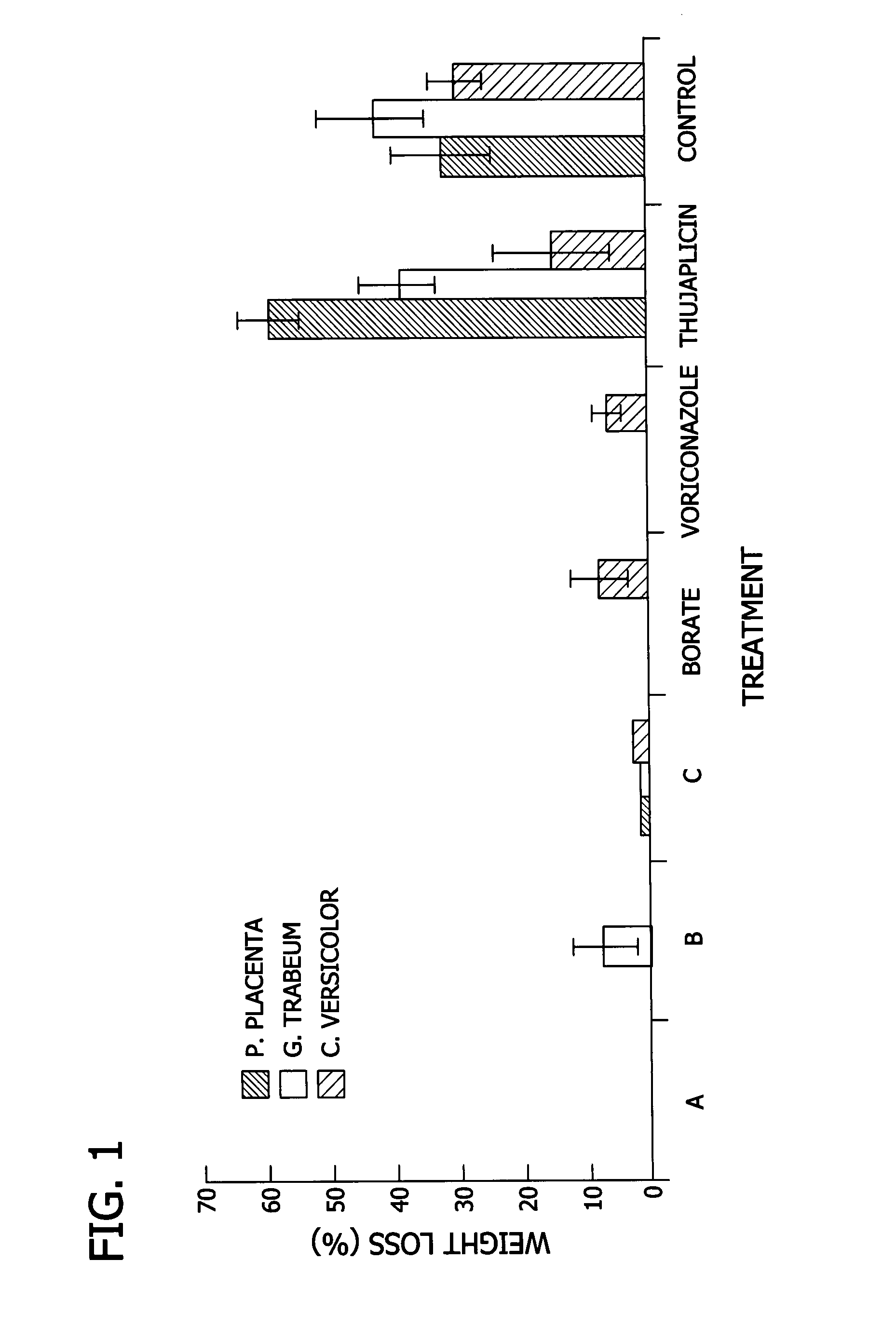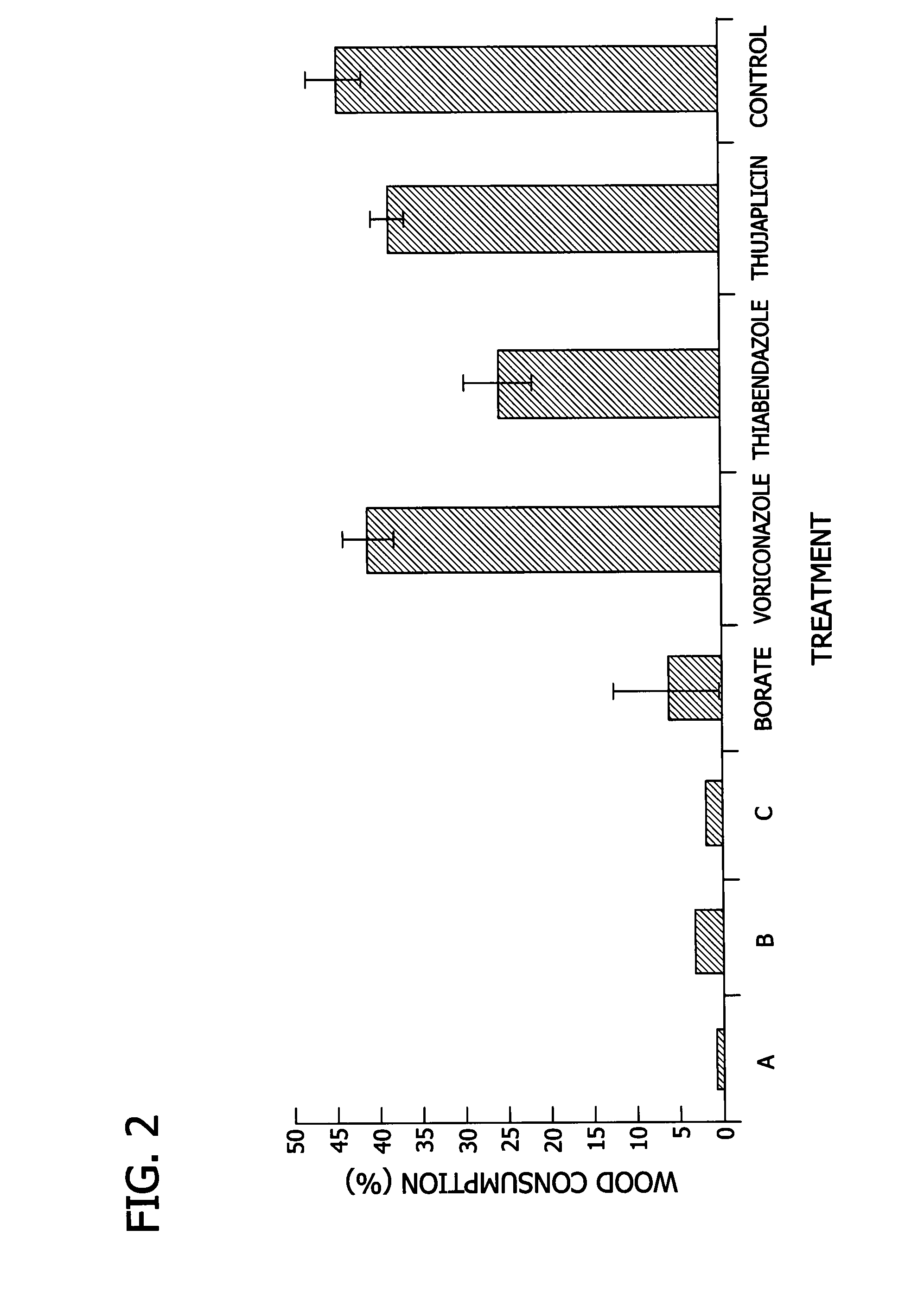Multi-component biocide composition for wood protection
a biocide composition and multi-component technology, applied in the field of multi-component biocide composition, can solve the problems of billions of dollars in damages annually, human and animal health concerns, and are susceptible to a host of natural destructive forces, and achieve the effect of improving protection
- Summary
- Abstract
- Description
- Claims
- Application Information
AI Technical Summary
Benefits of technology
Problems solved by technology
Method used
Image
Examples
example 1
[0047] In this Example, various compositions of biocide composition were prepared and tested for their efficacy in preventing mold fungal growth and decay fungal growth.
[0048] To prepare the biocide compositions, various amounts of components were added together. Various components (and their commercial suppliers) used in the biocide compositions are listed below:
[0049] Disodium octaborate tetrahydrate (DOT), a borate component available from U.S. Borax, Inc., Valencia, Calif.
[0050] Boric acid (0.1%), propionic acid (0.5%), and dimethylcocoamine (1.1%) (Bor-A+), an aqueous mixture of a borate component, propionic acid, and a quaternary amine component, available from Copper Care Wood Preservatives, Inc., Columbus, Nebr.
[0051] Voriconazole, an azole component, available from Pfizer, Inc., New York, N.Y.
[0052] Thiabendazole, an azole component, available from Sigma-Aldrich Chemical, St. Louis, Mo.
[0053] Thujaplicin(isopropyltropolone), available from Cedarome Canada, Inc., Montr...
example 2
[0062] In this Example, various biocide compositions were prepared and tested for their efficacy in preventing mold fungal growth. The efficacies of the biocide compositions were compared to compositions of commercially-used preservatives, fungicides, extracts, and pharmaceuticals that have known abilities to prevent mold fungal growth.
[0063] The various known preservatives, fungicides, extracts, and pharmaceuticals (and their commercial suppliers) are provided below: [0064] Wood Preservatives and Additives: (each was diluted from 2% (v / v) of the concentrate with water in a series of dilutions until no mold inhibition occurred on wood test specimens when tested using the ASTM standard used in the mold growth analysis of Example 1.)
[0065] Disodium octaborate tetrahydrate (DOT) (5% w / v), a borate component, available from Pole Maintenance Co., Columbus, Nebr.
[0066] CuBor (5% v / v), a borate component, available from Sigma Chemical, St. Louis, Mo. [0067] Food Preservatives: (each was...
example 3
[0096] In this Example, biocide compositions including an azole component or thujaplicin were prepared and tested for their efficacy in preventing mold fungal growth.
[0097] To prepare the biocide compositions, a borate-DMCA base was prepared by combining: boric acid (5%), a borate component available from National Boraxx, Cleveland, Ohio; propionic acid (25%), available from JT Baker, Phillipsburg, N.J.; dimethylcocoamine (55%), a quaternary amine component mixture, available from Lonza, Inc., Fair Lawn, N.J.; and polyethylene glycol (15%), a stabilizer available from Sigma Chemical, St. Louis, Mo. The other various components that can be used in the biocide compositions of this Example are listed below:
[0098] Voriconazole (0.1%), an azole component, available from Pfizer, Inc., New York, N.Y.
[0099] Thiabendazole (0.1% concentration diluted in 70% ethanol), an azole component, available from Sigma-Aldrich Chemical, St. Louis, Mo.
[0100] Tebuconazole (0.1%), an azole component, av...
PUM
| Property | Measurement | Unit |
|---|---|---|
| temperature | aaaaa | aaaaa |
| temperature | aaaaa | aaaaa |
| volume ratio | aaaaa | aaaaa |
Abstract
Description
Claims
Application Information
 Login to View More
Login to View More - R&D
- Intellectual Property
- Life Sciences
- Materials
- Tech Scout
- Unparalleled Data Quality
- Higher Quality Content
- 60% Fewer Hallucinations
Browse by: Latest US Patents, China's latest patents, Technical Efficacy Thesaurus, Application Domain, Technology Topic, Popular Technical Reports.
© 2025 PatSnap. All rights reserved.Legal|Privacy policy|Modern Slavery Act Transparency Statement|Sitemap|About US| Contact US: help@patsnap.com


